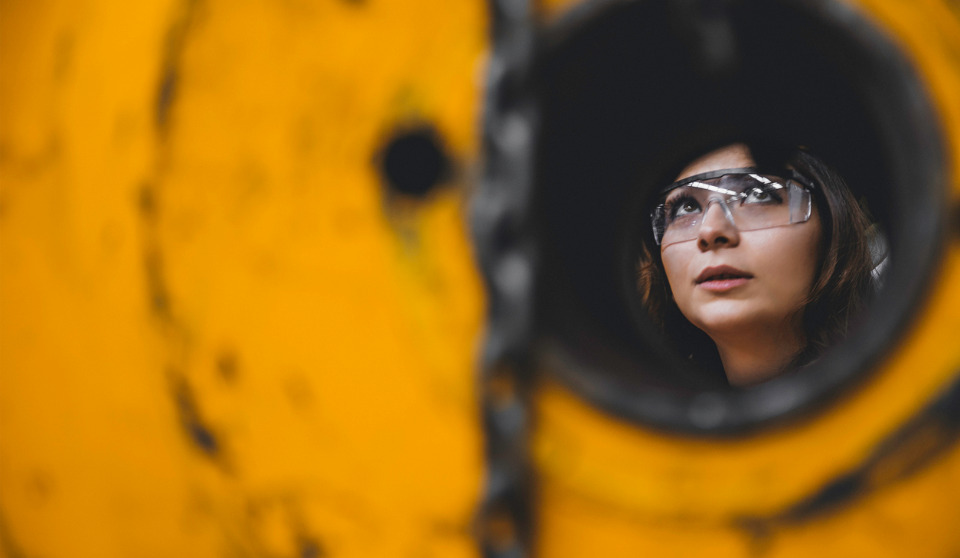Despite recent advances, female workers still face issues with access to PPE, notably protective clothing

One of the first conversations I had when I started writing for COS was with Stephanie Benay, chairperson of the Women in Occupational Health and Safety Society (WOHSS) and one of the cover stars of our May/June issue. When I asked her about issues facing women in the OHS sector today, she mentioned PPE. At the time, she said that “having PPE that fits you properly and is comfortable is critical to being able to do your job.”
The issue struck me at the time as it is one that — I am ashamed to admit — I had never really thought about. And, indeed, this topic has arisen more and more in the last few months whenever speaking with female OHS professionals. The main issue is the fit of protective clothing, which for many still doesn’t take into account the fact that workers come in all shapes and sizes. This lack of proper consideration seems to strongly affect female workers.
What are the dangers?
An article published in the American Journal of Industrial Medicine in 2016 entitled “Access to properly fitting personal protective equipment for female construction workers” highlights the difficulties that notably female construction workers face with regards to access and fit of protective clothing, including gloves, harnesses, safety vests, work boots, outwear, etc. The authors of the article found that, generally, equipment provided to female workers was too large. The study also noted that female workers faced other issues, such as having to purchase their own PPE or being exposed to health and safety hazards stemming from ill-fitting protective clothing.
On the topic of PPE for women in construction, the Canadian Centre for Occupational Health and Safety (CCOHS) states: “All workers have a right to a safe workplace. PPE designed for the dimensions of an average male worker means that female workers may be forced to rely on gear that is too large or disproportioned. From headwear to footwear, ill-fitting PPE can cause safety hazards, reduced dexterity from oversized gloves, hard hats that fall off, baggy coveralls catching on equipment, and trips and falls because footwear or shoe covers are too large.”
And “by recognizing the physical differences between genders, employers can show support for female workers in construction by treating them fairly. This can also support the changing construction workplace culture as more women enter the industry,” according to the CCOHS.
Some revealing statistics
In April, British trade union Prospect revealed the results of a study it conducted on PPE. The study highlighted that the most glaring issues arose with regards to protective clothing such as overalls, jackets and trousers. For example, the study found that for trousers, 16.6 per cent of male respondents said that their trousers didn’t fit well, while 48.5 per cent of women surveyed said that they didn’t fit well. The study raised similar numbers for overalls: 15.3 per cent of males surveyed said that their overalls didn’t fit well, while 44.7 per cent of female participants said that they didn’t fit well.
In addition, Prospect asked whether the PPE respondents wear is designed for men or women. Of the male respondents, 54.4 per cent said that PPE was made for men, 0.4 per cent responded that it was designed for women and 45.1 per cent said that they didn’t know. Meanwhile, 64.7 per cent of female respondents said that their PPE was designed for men, 15.9 per cent said that it was made for women and 19.5 per cent said that they didn’t know.
In 2016, a survey conducted by, among others, Prospect and the Trades Union Congress (TUC), found that 57 per cent of women who took part said that their PPE sometimes or significantly hampered their work. The survey also found that only 29 per cent of female respondents said that the PPE they use is specifically designed for women.
At an event hosted by WOHSS in November 2019, COS spoke with Lee-Anne Lyon-Bartley, director at large of WOHSS, who said, “As women, we do wear bras, and this is not something men are going to think about and that underwire could become a risk and a hazard. So, you need to make sure that you’re not wearing undergarments that have underwires because it does add an additional risk if you have to wear fire-rated clothing.”
She continued, “It’s called personal protective equipment — the first word is personal — and we’ve got to remember it’s got to fit the person. For example, women have hips and we want clothing that is going to fit us and not be so vertical. We want clothing that is going to be able to conform to our shape.”
Manufacturers play a large part
In 2006, the Ontario Women’s Directorate (OWD) and the Industrial Accident Prevention Association (IAPA) published a report entitled “Personal Protective Equipment for Women — Addressing the Need.” The report raised a number of questions on the availability and use of PPE for women.
The report details the crucial role manufacturers play in providing adequate protective clothing to workers, and notably female workers.
One of the report’s conclusions is that there is still very little communication around product availability. “While several manufacturers have begun to address the PPE needs of women, few have marketed their products in an aggressive way. And yet, there is a market out there: In the manufacturer’s survey results, those who advertised their products in women’s sizes realized outstanding sales revenues. However, this fact seems little known,” says the report.
Nevertheless, the report does indicate that around 75 per cent of manufacturers and suppliers surveyed had seen an increase in the previous three years for requests for PPE in women’s sizes or size ranges that would be suitable for women.
One common mistake manufacturers and sellers make with regards to protective clothing for women is thinking that appropriate clothing for female workers means simply providing an option in the colour pink — or in colourways that are regarded as being more traditionally “feminine.” Nevertheless, this way of thinking seems to be on its way out, with a number of PPE and protective clothing manufacturers branching out into apparel for female workers. Furthermore, there are a host of vendors and manufacturers who specialize entirely in clothing for women workers such as Safety Girl, Charm and Hammer, Covergalls or See Her Work.
There is also a need to focus on providing apparel for women who are pregnant, women with disabilities and women of different ethnicities or faiths who may need certain accommodations. However, there are brands looking to counter these deficiencies by providing a more inclusive range of protective clothing. For example, U.S.-based PPE brand AmorSui has started selling the the Rufaida Al-Aslamia hijab, a model that is specifically designed for women in STEM and health care who wear hijabs or headscarves. The hijab is fire-resistant and anti-microbial.
A closer look at women in health care
According to Statistics Canada, women make up a large part of the health-care profession. In 2016, Statistics Canada reported that women in the health-care sector made up 52 per cent of general practitioners and family physicians, 72 per cent of psychologists, 61 per cent of pharmacists, 87 per cent of social workers, 79 per cent of physiotherapists, 89 per cent of licensed practical nurses and 90 per cent of registered nurses and registered psychiatric nurses.
This is important to note, as health care as a profession is largely dominated by women — especially in long-term care, which has been hit particularly hard by the ongoing pandemic. Around 17 per cent of health-care workers in Canada have contracted the virus; the percentage has been relatively steady since the start of the outbreak.
Professor Jim Brophy of the University of Windsor says there are certain industries in which women are not seen, “and because they’re not visible, and because of the nature and stratification of our workforce — which is reinforced by gender — their voices are lacking in power or just simply ignored.”
Brophy co-authored a chapter in Sick of the System: Why the COVID-19 recovery must be revolutionary alongside Jane E. McArthur and Margaret M. Keith entitled “Novel Virus, Old Story,” which discusses the impact of the current pandemic on those working in the health-care sector.
“Firefighters wouldn't be expected to go into a fire with the kinds of protections that health-care workers were expected to go into COVID units with,” says Brophy.
Much has been made in recent months of shortages of PPE, notably N95 respirators, among health-care workers. COVID-19 has brought to light many uncomfortable truths, one of those being the lack of PPE for health-care workers and the fact that, even if available, limited models may not be suitable for different face shapes, notably women’s faces.
“My understanding is that they actually do have a smaller size [of N95 masks]. I think there's two sizes, which are supposed to account for the different sizes of people's faces, including the difference between a male face and a female face,” says Brophy. “But I don't think I have heard of any health-care workers in Ontario being given different choices on face size. And I don't think that there's been any such thing about the N95 being specifically constructed for women in the first instance or accounted for differences in women's faces. And that's in an industry where the vast majority of frontline workers are women.”
Aside from health care, Brophy says, in other industries that are female dominated such as food production or teaching, what level of protection will be provided to those workers? “Where women predominate and make up a substantial portion of the workforce, their levels of protection will be many times less than what would be comparable in areas where men are a majority,” he says.
Conversely, in industries that are traditionally male dominated such as construction, Brophy says that women seem to be expected to be exactly like their male counterparts with regards to their protective equipment and clothing needs. Many hazardous or high-risk sectors are male-dominated. Statistic Canada’s Labour Force report indicates that, in 2019, there were a total of 182,000 women in the construction sector out of a total workforce of 1.463 million.
Conscious or unconscious bias?
Ill-fitting protective clothing is dangerous for any worker, so why is this only recently becoming a concern for women? In her 2019 book, Invisible Women: Data Bias in a World Designed for Men, author and feminist advocate Caroline Criado Perez says data exists that proves women may have smaller hands than men. She writes:
“There is plenty of data showing that women have, on average, smaller hands than men, and yet we continue to design equipment around the average male hand as if one-size-fits-men is the same size as one-size-fits-all. This one-size-fits-men approach to supposedly gender-neutral products is disadvantaging women.”
The examples are broadly about pianists and tech objects such as smartphones or tablets, but one could potentially apply this to PPE — notably gloves in this case. And this is just one small example of gender bias in design. Whether you agree with Criado Perez or not, sexism and gender biases could be a potential explanation behind why protective clothing for women continues to be ill-fitting, and this is certainly an uncomfortable idea with which to wrestle.
Brophy says that lack of properly fitting protective clothing could be because of the patriarchal structure of our society and the level of power men have to wield their influence in the decision-making process in the workplace and within society as a whole.
Speaking specifically about the health-care sector, Brophy says, “You can’t disconnect the violence in health care, which is an epidemic, to the disconnect between the violence against women in society, which is an epidemic. It’s really connected how both those things happen. Why is it that women … are most likely to be victimized both in the work environment and in society? And why can’t they get proper levels of protection? Why would their level of protection be lesser?”
More innocently, the dearth of properly fitting clothing for female workers could simply be employers and manufacturers trying to catch up to a rapidly-evolving workplace, one in which female workers are increasingly entering less “traditional” work environments.
In any case, be it a conscious or unconscious bias, women need to be afforded access to properly fitting protective clothing.
Where do we go from here?
Women in both male-dominated and, surprisingly, female-dominated professions seem to be facing this issue. With the current pandemic reshaping every aspect of our work lives, we could see a push in a positive direction as COVID-19 has brought to light the lack of adequate PPE in the health-care sector – and in many other sectors.
Indeed, as we have seen earlier, there is an increasing market for female protective clothing — but the supply needs to match the demand.
The OWD and IAPA report on PPE for women concludes with a list of how women who wear PPE can be more effective. One recommendation was to be vocal about one’s needs and increase participation in decision-making such as joint health and safety committees. But the report doesn’t place the onus entirely on women to act, and enjoins governments, manufacturers, standards agencies, employers, unions, etc. to act and listen to female voices.
There are initiatives around the world that are beginning to focus on this issue. For example, in 2016, the United Nations Economic Commission for Europe (UNECE) launched its Gender Responsive Standards Initiative. This initiative aims to provide a path for standards bodies to develop standards and technical regulations that are gender responsive.
Ultimately, though, access to properly fitting protective clothing perhaps needs to be refocused as a worker issue rather than a gender issue, because when it comes to the health and safety of each and every worker, there should be no excuses and no exceptions.
This article originally appeared in the Nov/Dec 2020 issue of COS.





